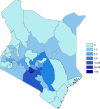Patient characteristics of the Accident and Emergency Department of Kenyatta National Hospital, Nairobi, Kenya: a cross-sectional, prospective analysis
- PMID: 29025826
- PMCID: PMC5652550
- DOI: 10.1136/bmjopen-2016-014974
Patient characteristics of the Accident and Emergency Department of Kenyatta National Hospital, Nairobi, Kenya: a cross-sectional, prospective analysis
Abstract
Background: Resource-limited settings are increasingly experiencing a 'triple burden' of disease, composed of trauma, non-communicable diseases (NCDs) and known communicable disease patterns. However, the epidemiology of acute and emergency care is not well characterised and this limits efforts to further develop emergency care capacity.
Objective: To define the burden of disease by describing the patient population presenting to the Accident and Emergency Department (A&E) at Kenyatta National Hospital (KNH) in Kenya.
Methods: We completed a prospective descriptive assessment of patients in KNH's A&E obtained via systematic sampling over 3 months. Research assistants collected data directly from patients and their charts. Chief complaint and diagnosis codes were grouped for analysis. Patient demographic characteristics were described using the mean and SD for age and n and percentages for categorical variables. International Classification of Disease 10 codes were categorised by 2013 Global Burden of Disease Study methods.
Results: Data were collected prospectively on 402 patients with an average age of 36 years (SD 19), and of whom, 50% were female. Patients were most likely to arrive by taxi or bus (39%), walking (28%) or ambulance (17%). Thirty-five per cent of patients were diagnosed with NCDs, 24% with injuries and 16% with communicable diseases, maternal and neonatal conditions. Overall, head injury was the single most common final diagnosis and occurred in 32 (8%) patients. The most common patient-reported mechanism for head injury was road traffic accident (39%).
Conclusion: This study estimates the characteristics of the A&E population at a tertiary centre in Kenya and highlights the triple burden of disease. Our findings emphasise the need for further development of emergency care resources and training to better address patient needs in resource-limited settings, such as KNH.
Keywords: Trauma Management; accident & emergency medicine; epidemiology; international health services.
© Article author(s) (or their employer(s) unless otherwise stated in the text of the article) 2017. All rights reserved. No commercial use is permitted unless otherwise expressly granted.
Conflict of interest statement
Competing interests: None declared.
Figures



References
-
- Marquez P V, Farrington JL. The challenge of non-communicable diseases and road trafficinjuries in Sub-Saharan Africa. An overview. 79293: Washington DC World Bank, 2013.
MeSH terms
LinkOut - more resources
Full Text Sources
Other Literature Sources
Medical
